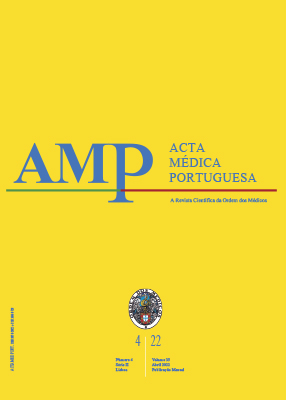Alcohol Drinking in Higher Education Students from Coimbra and the Impact of Academic Festivities
DOI:
https://doi.org/10.20344/amp.12366Keywords:
Alcohol Drinks, Alcoholic Intoxication, Binge Drinking, Ceremonial Behavior, Graduate EducationAbstract
Introduction: The international and national literature as well as studies carried out in universities in Portugal show there is excessive alcohol consumption and binge drinking. However, no relation with alcohol consumption and college parties has yet been established. The aim of this study was to assess the association between alcohol consumption and binge drinking with college parties, and also to understand specific patterns of alcohol consumption by gender and years of university attendance.
Material and Methods: A survey comprised of the “Alcohol Use Disorders Identification Test – Consumption” (AUDIT-C) and the question “What is your most consumed drink?” referring to months without and with college parties, was disseminated in the University of Coimbra Facebook® page to students of the University of Coimbra and of the Polytechnic Institute of Coimbra seventeen years old and over.
Results: The AUDIT-C score in college party months is higher than in months without such parties with strong, positive and significant correlation (ρ = 0.711; ρ < 0.001). In months without college parties, 41.8% of females and 24.0% of males have a positive AUDIT-C. In months with college parties, 73.8% of females and 56.3% of males have a positive AUDIT-C. In months with college parties, females have higher risk of excessive consumption (ρ < 0.001) and drink a higher amount of spirits / shots. There is a significant difference in the most consumed drinks between genders (ρ < 0.001).
Discussion: Alcohol consumption is higher in those with less years in college attendance, but college parties seem to have a proportional impact regardless of the number of years of college attendance. In a month with college parties, there is more binge drinking and higher consumption than the daily maximum recommended amount. Males consume a higher amount of spirits / shots.
Conclusion: College parties allow for more opportunities of pre-existing binge drinking. The way young people face alcohol consumption is a major problem to be addressed.
Downloads
Downloads
Published
How to Cite
Issue
Section
License
Copyright (c) 2021 Acta Médica Portuguesa

This work is licensed under a Creative Commons Attribution-NonCommercial 4.0 International License.
All the articles published in the AMP are open access and comply with the requirements of funding agencies or academic institutions. The AMP is governed by the terms of the Creative Commons ‘Attribution – Non-Commercial Use - (CC-BY-NC)’ license, regarding the use by third parties.
It is the author’s responsibility to obtain approval for the reproduction of figures, tables, etc. from other publications.
Upon acceptance of an article for publication, the authors will be asked to complete the ICMJE “Copyright Liability and Copyright Sharing Statement “(http://www.actamedicaportuguesa.com/info/AMP-NormasPublicacao.pdf) and the “Declaration of Potential Conflicts of Interest” (http:// www.icmje.org/conflicts-of-interest). An e-mail will be sent to the corresponding author to acknowledge receipt of the manuscript.
After publication, the authors are authorised to make their articles available in repositories of their institutions of origin, as long as they always mention where they were published and according to the Creative Commons license.









